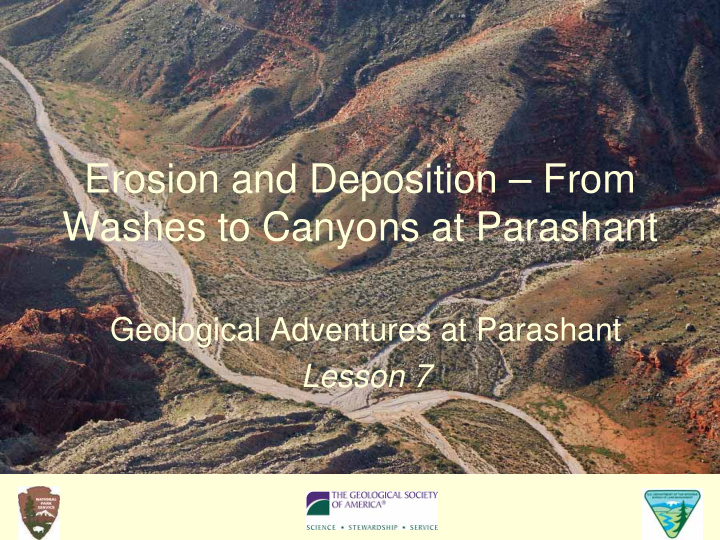



Erosion and Deposition – From Washes to Canyons at Parashant Geological Adventures at Parashant Lesson 7
Objectives • Running water orients clasts in streams in ways that enable us to reconstruct the directions of ancient stream flow; • Erosion is the transport of sediment by wind, water, gravity, and ice, and wears down the land; • Deposition is the settling of eroded sediment at a lower elevation and builds up the land; • Running water is the most important agent of erosion in the desert; • Rocks are broken into smaller pieces over time through chemical and mechanical weathering; • The composition of rocks in ancient stream deposits provides clues about the existence and nature of ancient mountains.
WORKSHEET 7.1 – OLDER WASH DEPOSITS EXPOSED AT WHITMORE WASH
FIGURE 1 Sample interpretation of clast orientation for 20 clasts in a wash deposit exposed at Whitmore Wash. All 20 clasts are oriented with the high end pointing to the left.
WORKSHEET 7.2 – OLDER WASH DEPOSITS EXPOSED AT WHITMORE WASH
WORKSHEET 7.3 – WASH ROCKS UPPER LEFT
WORKSHEET 7.4 – WASH ROCKS UPPER RIGHT
WORKSHEET 7.5 – WASH ROCKS LOWER LEFT
WORKSHEET 7.6 – WASH ROCKS LOWER RIGHT
FIGURE 2 Sample interpretation of Worksheet 7.3 - Wash Rocks Upper Left.
Figures in the Student Text
Water flow direction A Sediment B FIGURE 7.1 Diagram of two rocks on the bottom of a wash. The dashed line is level of water during a thunderstorm.
FIGURE 7.2 Rocks exposed in Whitmore Wash at Parashant. The box outlines the area shown in Worksheet 7.1.
FIGURE 7.3 This large block of limestone has paused temporarily on its trip downhill under the force of gravity.
FIGURE 7.4 Wind erosion removes finer particles of sediment, leaving a coarse-grained desert pavement behind.
FIGURE 7.5 Canyon forming north of Parashant. Down slope is to the lower right. Note how the canyon becomes wider and deeper over its course, and how smaller channels feed into the larger main channel.
FIGURE 7.6 Alluvium covers the slopes along the Grand Wash Cliffs at Parashant to the point where little of the sedimentary rock layers are visible.
FIGURE 7.8 Chemical weathering gives the Navajo Sandstone at Parashant its red color. Mechanical weathering disintegrates it into sand, seen at the base of the outcrop.
FIGURE 7.9 The person who photographed this flash flood in the Grand Wash at Parashant noted hearing sounds made by boulders tumbling in the water.
FIGURE 7.10 Clasts in an ancient conglomerate. Penny for scale.
Recommend
More recommend